Highly Thermal Conductive Graphite Films Derived from the Graphitization of Chemically Imidized Polyimide Films
Abstract
:1. Introduction
2. Experimental Section
2.1. Preparation of Graphite Film
2.2. Characterization of Materials
2.3. Measurement of Thermal Conductivity
3. Results and Discussion
3.1. Structure and Properties of PI Films
3.2. Morphology and Structure of Graphited PI Films
3.3. Thermal Conductivity of Graphited PI Films
4. Conclusions
Supplementary Materials
Author Contributions
Funding
Institutional Review Board Statement
Informed Consent Statement
Data Availability Statement
Conflicts of Interest
References
- Wu, T.; Xu, Y.; Wang, H.; Sun, Z.; Zou, L. Efficient and inexpensive preparation of graphene laminated film with ultrahigh thermal conductivity. Carbon 2021, 171, 639–645. [Google Scholar] [CrossRef]
- Li, S.; Zheng, Z.; Liu, S.; Chi, Z.; Chen, X.; Zhang, Y.; Xu, J. Ultrahigh thermal and electric conductive graphite films prepared by g-C3N4 catalyzed graphitization of polyimide films. Chem. Eng. J. 2021, 430, 132530. [Google Scholar] [CrossRef]
- Feng, W.; Qin, M.; Feng, Y. Toward highly thermally conductive all-carbon composites: Structure control. Carbon 2016, 109, 575–597. [Google Scholar] [CrossRef]
- Balandin, A.A. Thermal properties of graphene and nanostructured carbon materials. Nat. Mater. 2011, 10, 569–581. [Google Scholar] [CrossRef] [Green Version]
- Lee, H.J.; Lim, G.; Yang, E.; Kim, Y.S.; Kwak, M.G.; Kim, Y. Thermally Conductive Film Fabricated Using Perforated Graphite Sheet and UV-Curable Pressure-Sensitive Adhesive. Nanomaterials 2021, 11, 93. [Google Scholar] [CrossRef]
- Chen, S.; Wang, Q.; Zhang, M.; Huang, R.; Huang, Y.; Tang, J.; Liu, J. Scalable production of thick graphene film for next generation thermal management application. Carbon 2020, 167, 270–277. [Google Scholar] [CrossRef]
- Zhang, L.; Zhang, G.; Liu, C.; Fan, S. High-Density Carbon Nanotube Buckypapers with Superior Transport and Mechanical Properties. Nano Lett. 2012, 12, 4848–4852. [Google Scholar] [CrossRef]
- Murakami, M.; Watanabe, K.; Yoshimura, S. High-quality pyrographite films. Appl. Phys. Lett. 1986, 48, 1594–1596. [Google Scholar] [CrossRef]
- Murakami, M.; Nishiki, N.; Nakamura, K.; Ehara, J.; Okada, H.; Kouzaki, T.; Watanabe, K.; Hoshi, T.; Yoshimura, S. High-quality and highly oriented graphited graphite block from polycondensation polymer films. Carbon 1992, 30, 255–262. [Google Scholar] [CrossRef]
- Yutaka, K.; Hishiyama, Y. Highly crystallized graphite films prepared by high-temperature heat treatment from carbonized aromatic polyimide films. Carbon 1995, 33, 773–777. [Google Scholar] [CrossRef]
- Hou, S.; He, S.; Zhu, T.; Li, J.; Ma, L.; Du, H.; Shen, W.; Kang, F.; Huang, Z.-H. Environment-friendly preparation of exfoliated graphite and functional graphite sheets. J. Mater. 2021, 7, 136–145. [Google Scholar] [CrossRef]
- Balandin, A.A.; Ghosh, S.; Bao, W.; Calizo, I.; Teweldebrhan, D.; Miao, F.; Lau, C.N. Superior Thermal Conductivity of Single-Layer Graphene. Nano Lett. 2008, 8, 902–907. [Google Scholar] [CrossRef] [PubMed]
- Balandin, A.A. Phononics of Graphene and Related Materials. ACS Nano 2020, 14, 5170–5178. [Google Scholar] [CrossRef] [PubMed]
- Nika, D.L.; Balandin, A.A. Phonons and thermal transport in graphene and graphene-based materials. Rep. Prog. Phys. 2017, 80, 036502. [Google Scholar] [CrossRef] [Green Version]
- Zhu, Y.; Peng, Q.; Qin, Y.; Zhao, X.; Xu, L.; Chen, Q.; Li, Y.; Xu, Z.; He, X. Graphene–Carbon Composite Films as Thermal Management Materials. ACS Appl. Nano Mater. 2020, 3, 9076–9087. [Google Scholar] [CrossRef]
- Kong, Q.Q.; Liu, Z.; Gao, J.G.; Chen, C.M.; Zhang, Q.; Zhou, G.M.; Tao, Z.C.; Zhang, X.H.; Wang, M.Z.; Li, F.; et al. Hierarchical Graphene-Carbon Fiber Composite Paper as a Flexible Lateral Heat Spreader. Adv. Funct. Mater. 2014, 24, 4222–4228. [Google Scholar] [CrossRef]
- Jia, H.; Kong, Q.Q.; Yang, X.; Xie, L.J.; Sun, G.H.; Liang, L.L.; Chen, J.P.; Liu, D.; Guo, Q.G.; Chen, C.M. Dual-functional graphene/carbon nanotubes thick film: Bidirectional thermal dissipation and electromagnetic shielding. Carbon 2021, 171, 329–340. [Google Scholar] [CrossRef]
- Zou, R.; Liu, F.; Hu, N.; Ning, H.; Gong, Y.; Wang, S.; Huang, K.; Jiang, X.; Xu, C.; Fu, S.; et al. Graphene/Graphitized Polydopamine/Carbon Nanotube All-Carbon Ternary Composite Films with Improved Mechanical Properties and Through-Plane Thermal Conductivity. ACS Appl. Mater. Interfaces 2020, 12, 57391–57400. [Google Scholar] [CrossRef]
- Inagaki, M.; Takeichi, T.; Hishiyama, Y.; Oberlin, A. High quality graphited films produced from aromatic polyimides. Chem. Phys. Carbon 1999, 26, 245–333. [Google Scholar]
- Inagaki, M.; Ohta, N.; Hishiyama, Y. Aromatic polyimides as carbon precursors. Carbon 2013, 61, 1–21. [Google Scholar] [CrossRef]
- Huang, H.; Ming, X.; Wang, Y.; Guo, F.; Liu, Y.; Xu, Z.; Peng, L.; Gao, C. Polyacrylonitrile-derived thermally conductive graphite film via graphene template effect. Carbon 2021, 180, 197–203. [Google Scholar] [CrossRef]
- Murakami, M.; Tatami, A.; Tachibana, M. Fabrication of high quality and large area graphite thin films by pyrolysis and graphitization of polyimides. Carbon 2019, 145, 23–30. [Google Scholar] [CrossRef]
- Inagaki, M.; Harada, S.; Sato, T.; Nakajima, T.; Horino, Y.; Morita, K. Carbonization of polyimide film “Kapton”. Carbon 1989, 27, 253–257. [Google Scholar] [CrossRef]
- Inagakia, M.; Sakamoto, K.-i. Carbonization and graphitization of polyimide Upilex. J. Mater. Res. 1991, 6, 1108–1113. [Google Scholar] [CrossRef]
- Inagaki, M.; Meng, L.J.; Ibuki, T.; Sakai, M. Carbonization and graphitization of pollyimide film “Novax”. Carbon 1991, 29, 1239–1243. [Google Scholar] [CrossRef]
- Ruan, K.P.; Guo, Y.Q.; Gu, J.W. Liquid Crystalline Polyimide Films with High Intrinsic Thermal Conductivities and Robust Toughness. Macromolecules 2021, 54, 4934–4944. [Google Scholar] [CrossRef]
- Bin, Y.; Oishi, K.; Koganemaru, A.; Zhu, D.; Matsuo, M. Catalytic effect of nickel under carbonization of polyimide films. Carbon 2005, 43, 1617–1627. [Google Scholar] [CrossRef]
- Niu, Y.; Zhang, X.; Wu, J.; Zhao, J.; Yan, X.; Li, Y. Catalytic and enhanced effects of silicon carbide nanoparticles on carbonization and graphitization of polyimide films. RSC Adv. 2014, 4, 42569–42576. [Google Scholar] [CrossRef]
- Weng, M.; Jian, L.; Feng, X.; Luo, X.; Hu, J.; Zhang, J.; Liu, Y.; Min, Y. High oriented graphite film with high thermal conductivity prepared by pure polyimide film formed with catalyst pyridine. Ceram. Int. 2021, 47, 24519–24526. [Google Scholar] [CrossRef]
- Ou, X.; Chen, S.; Lu, X.; Lu, Q. Enhancement of thermal conductivity and dimensional stability of polyimide/boron nitride films through mechanochemistry. Compos. Commun. 2021, 23. [Google Scholar] [CrossRef]
- Wang, Y.; Zhang, X.; Ding, X.; Zhang, P.; Shu, M.; Zhang, Q.; Gong, Y.; Zheng, K.; Tian, X. Imidization-induced carbon nitride nanosheets orientation towards highly thermally conductive polyimide film with superior flexibility and electrical insulation. Compos. Part B Eng. 2020, 199, 108267. [Google Scholar] [CrossRef]
- Hatori, H.; Yamada, Y.; Shiraishi, M. In-plane orientation and graphitizability of polyimide films. Carbon 1992, 31, 763–766. [Google Scholar] [CrossRef]
- Wang, Z.H.; Chen, X.; Yang, H.X.; Zhao, J.; Yang, S.Y. The In-plane Orientation and Thermal Mechanical Properties of the Chemically Imidized Polyimide Films. Chin. J. Polym. Sci. 2018, 37, 268–278. [Google Scholar] [CrossRef]
- Hoque, M.S.B.; Koh, Y.R.; Braun, J.L.; Mamun, A.; Liu, Z.Y.; Huynh, K.; Liao, M.E.; Hussain, K.; Cheng, Z.; Hoglund, E.R.; et al. High In-Plane Thermal Conductivity of Aluminum Nitride Thin Films. ACS Nano 2021, 15, 9588–9599. [Google Scholar] [CrossRef]
- Qiu, L.; Zhang, X.; Guo, Z.; Li, Q. Interfacial heat transport in nano-carbon assemblies. Carbon 2021, 178, 391–412. [Google Scholar] [CrossRef]
- Zou, R.; Liu, F.; Hu, N.; Ning, H.; Jiang, X.; Xu, C.; Fu, S.; Li, Y.; Zhou, X.; Yan, C. Carbonized polydopamine nanoparticle reinforced graphene films with superior thermal conductivity. Carbon 2019, 149, 173–180. [Google Scholar] [CrossRef]
- Unsal, E.; Cakmak, M. Molecular mechanism of temporal physico/chemical changes that take place during imidization of polyamic acid: Coupled real-time rheo-optical and IR dichroism measurements. Polymer 2014, 55, 6569–6576. [Google Scholar] [CrossRef]
- Zhou, L.; Li, Y.; Wang, Z.; Zhang, M.; Wang, X.; Niu, H.; Wu, D. Preparation of polyimide films via microwave-assisted thermal imidization. RSC Adv. 2019, 9, 7314–7320. [Google Scholar] [CrossRef] [Green Version]
- Roderick, W.R.; Bhatia, P.L. Action of Trifluoroacetic Anhydride on N-Substituted Amic Acids. J. Org. Chem. 1963, 28, 2018–2024. [Google Scholar] [CrossRef]
- Lin, D.; Liu, Y.; Jia, Z.; Qi, S.; Wu, D. Structural Evolution of Macromolecular Chain During Pre-imidization Process and Its Effects on Polyimide Film Properties. J. Phys. Chem. B 2020, 124, 7969–7978. [Google Scholar] [CrossRef]
- Huang, C.; Li, J.; Sun, D.; Xuan, R.; Sui, Y.; Li, T.; Shang, L.; Zhang, G.; Sun, R.; Wong, C.P. Comprehensive properties study of low-temperature imidized polyimide with curing accelerators. J. Mater. Chem. C 2020, 8, 14886–14894. [Google Scholar] [CrossRef]
- Song, R.; Wang, Q.; Mao, B.; Wang, Z.; Tang, D.; Zhang, B.; Zhang, J.; Liu, C.; He, D.; Wu, Z.; et al. Flexible graphite films with high conductivity for radio-frequency antennas. Carbon 2018, 130, 164–169. [Google Scholar] [CrossRef]
- Chen, C.M.; Huang, J.Q.; Zhang, Q.; Gong, W.Z.; Yang, Q.H.; Wang, M.Z.; Yang, Y.G. Annealing a graphene oxide film to produce a free standing high conductive graphene film. Carbon 2012, 50, 659–667. [Google Scholar] [CrossRef]
- Takeichi, T.; Zuo, M.; Hasegawa, M. Role of the In-Plane Orientation of Polyimide Films in Graphitization. J. Polym. Sci. Part B Polym. Phys. 2001, 39, 3011–3019. [Google Scholar] [CrossRef]
- Pachfule, P.; Shinde, D.; Majumder, M.; Xu, Q. Fabrication of carbon nanorods and graphene nanoribbons from a metal-organic framework. Nat. Chem. 2016, 8, 718–724. [Google Scholar] [CrossRef] [PubMed]
- Cançado, L.G.; Takai, K.; Enoki, T.; Endo, M.; Kim, Y.A.; Mizusaki, H.; Jorio, A.; Coelho, L.N.; Magalhães-Paniago, R.; Pimenta, M.A. General equation for the determination of the crystallite size La of nanographite by Raman spectroscopy. Appl. Phys. Lett. 2006, 88, 163106. [Google Scholar] [CrossRef]
- Malard, L.M.; Pimenta, M.A.; Dresselhaus, G.; Dresselhaus, M.S. Raman spectroscopy in graphene. Phys. Rep. 2009, 473, 51–87. [Google Scholar] [CrossRef]
- Cancado, L.G.; Takai, K.; Enoki, T.; Endo, M.; Kim, Y.A.; Mizusaki, H.; Speziali, N.L.; Jorio, A.; Pimenta, M.A. Measuring the degree of stacking order in graphite by Raman spectroscopy. Carbon 2008, 46, 272–275. [Google Scholar] [CrossRef] [Green Version]
- Li, H.; Dai, S.; Miao, J.; Wu, X.; Chandrasekharan, N.; Qiu, H.; Yang, J. Enhanced thermal conductivity of graphene/polyimide hybrid film via a novel “molecular welding” strategy. Carbon 2018, 126, 319–327. [Google Scholar] [CrossRef]
- Renteria, J.D.; Ramirez, S.; Malekpour, H.; Alonso, B.; Centeno, A.; Zurutuza, A.; Cocemasov, A.I.; Nika, D.L.; Balandin, A.A. Strongly Anisotropic Thermal Conductivity of Free-Standing Reduced Graphene Oxide Films Annealed at High Temperature. Adv. Funct. Mater. 2015, 25, 4664–4672. [Google Scholar] [CrossRef]
- Teng, C.; Xie, D.; Wang, J.; Yang, Z.; Ren, G.; Zhu, Y. Ultrahigh Conductive Graphene Paper Based on Ball-Milling Exfoliated Graphene. Adv. Funct. Mater. 2017, 27, 1700240. [Google Scholar] [CrossRef]
- Chen, X.; Deng, X.; Kim, N.Y.; Wang, Y.; Huang, Y.; Peng, L.; Huang, M.; Zhang, X.; Chen, X.; Luo, D.; et al. Graphitization of graphene oxide films under pressure. Carbon 2018, 132, 294–303. [Google Scholar] [CrossRef]
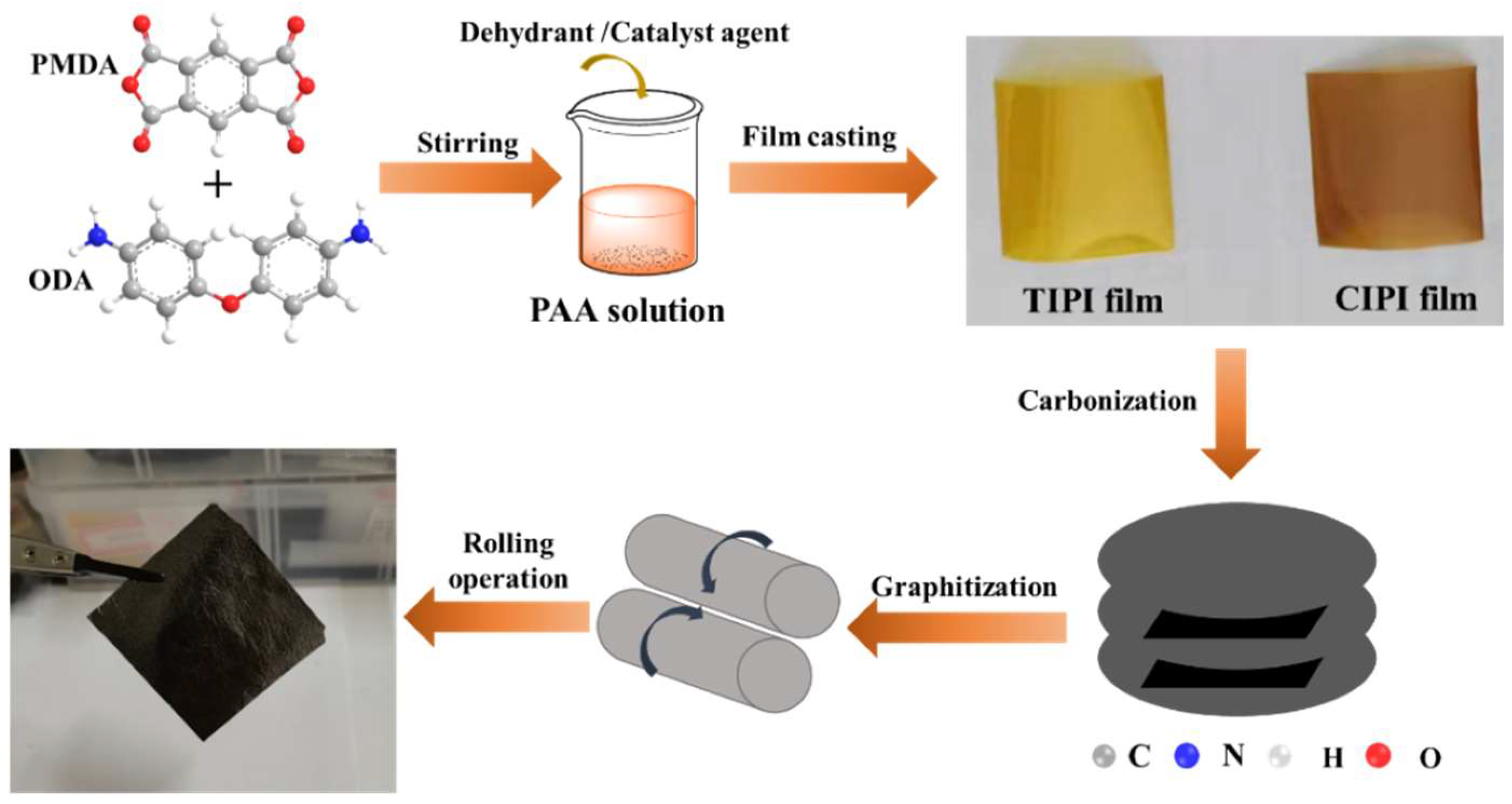
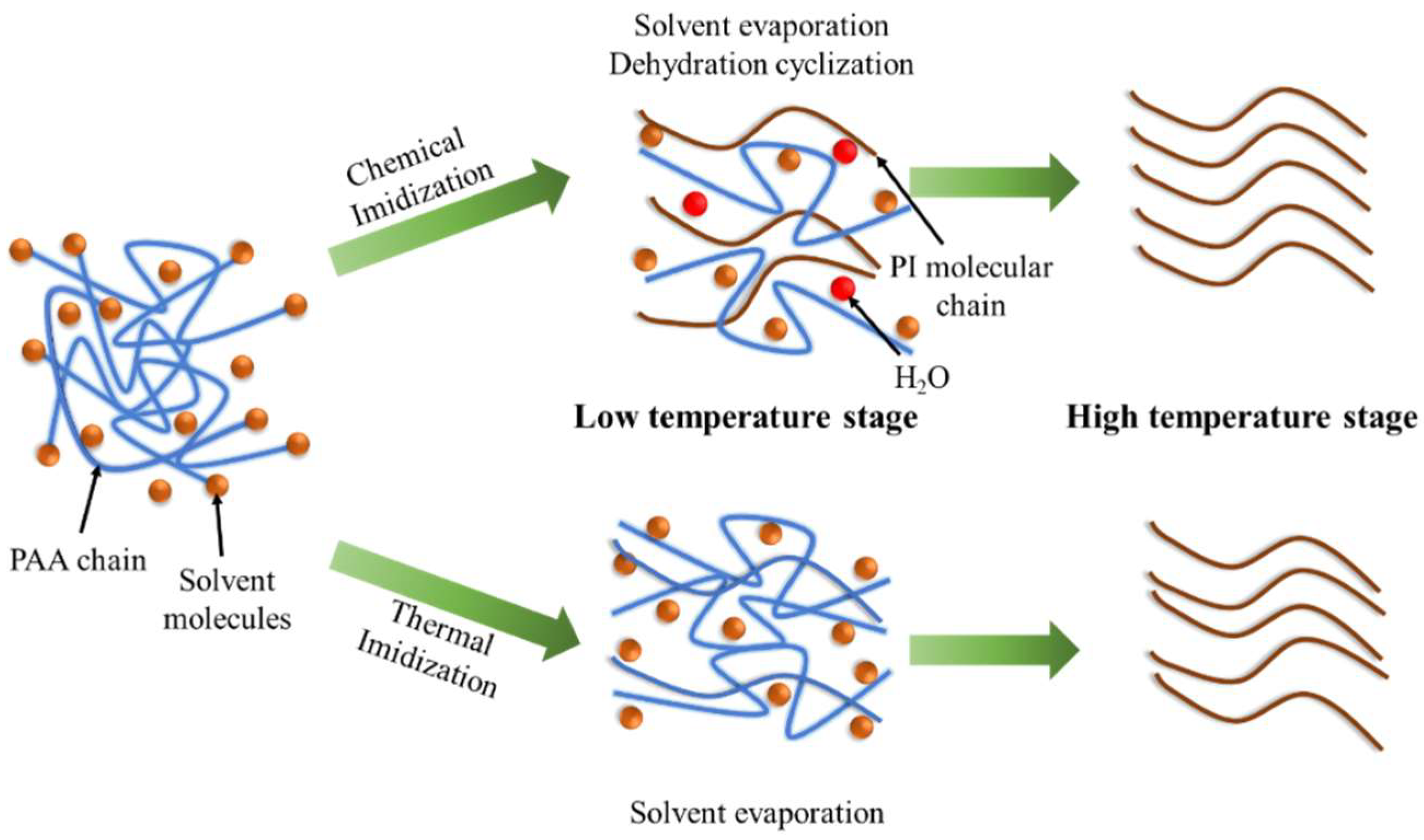
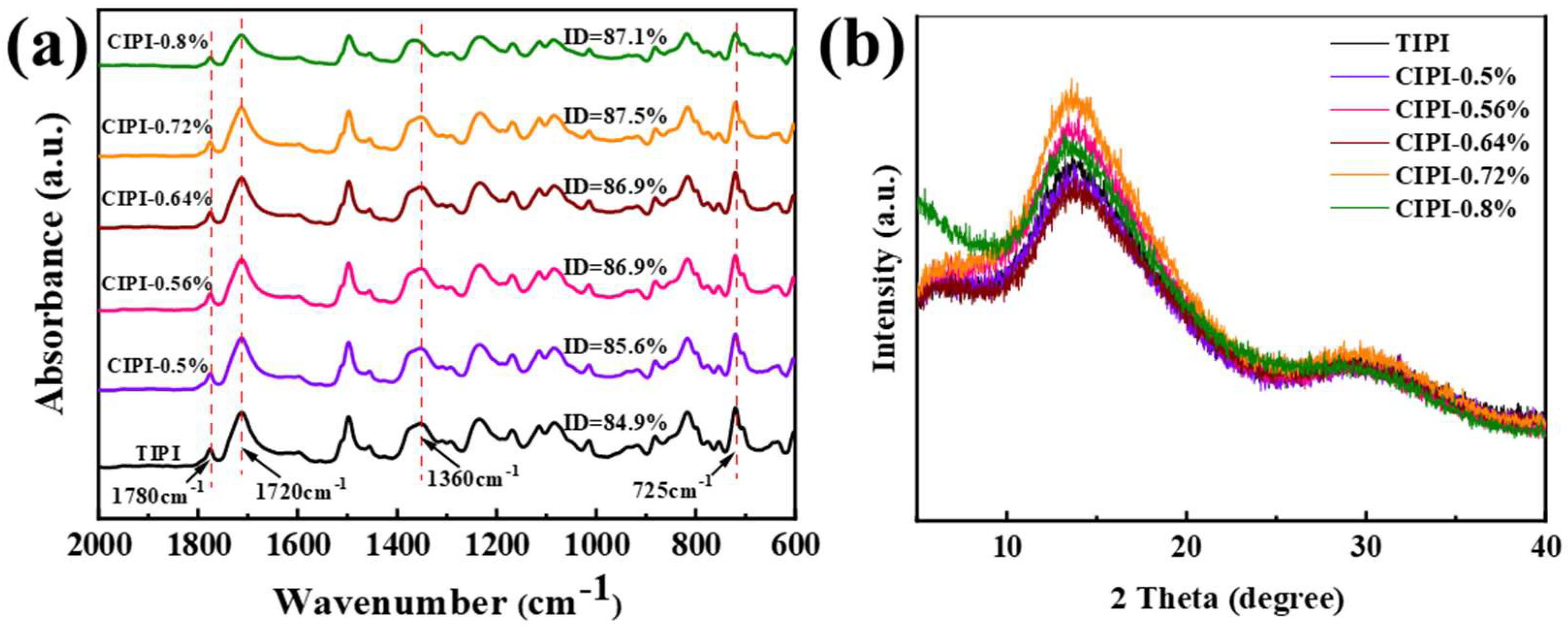
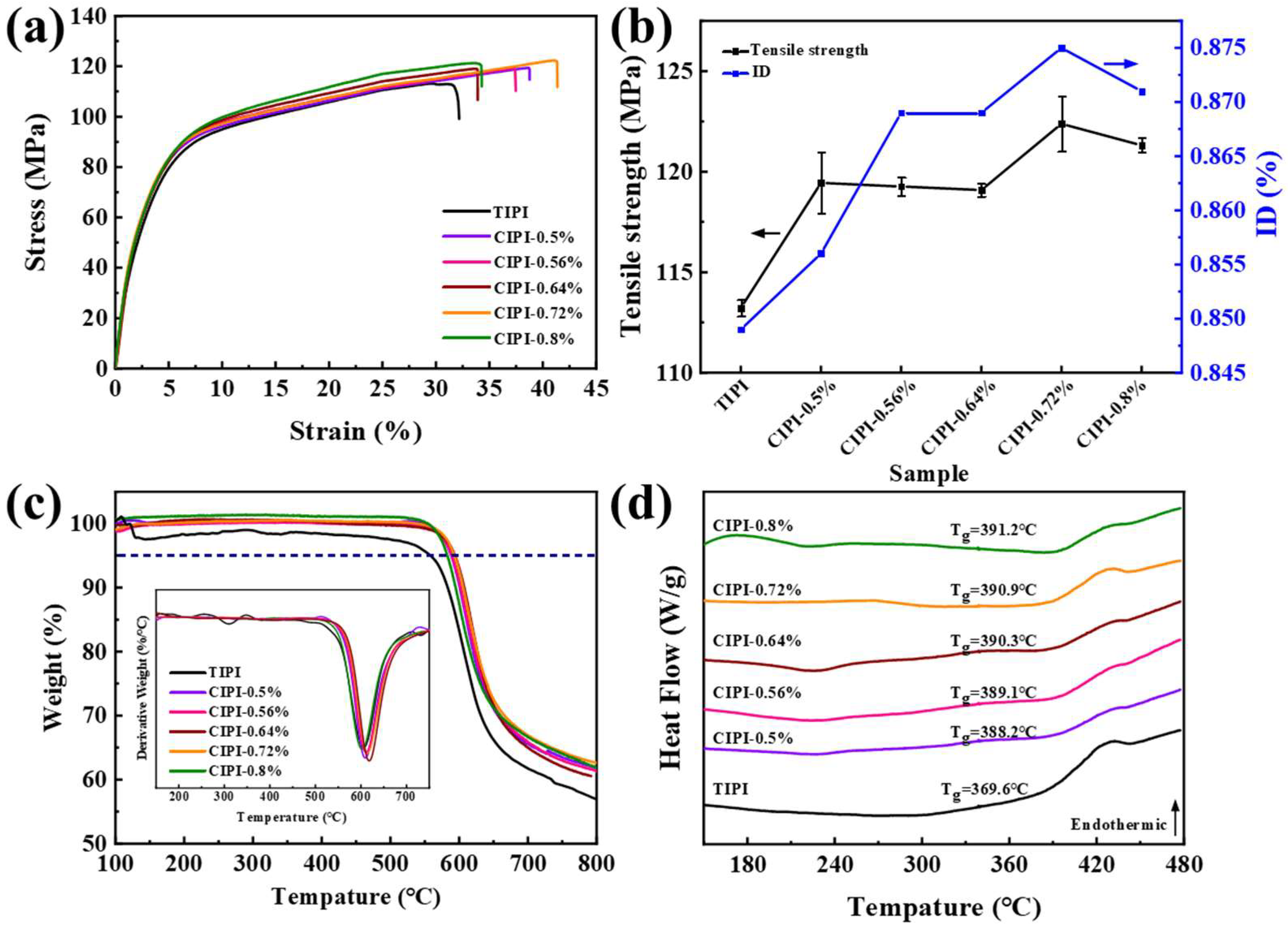
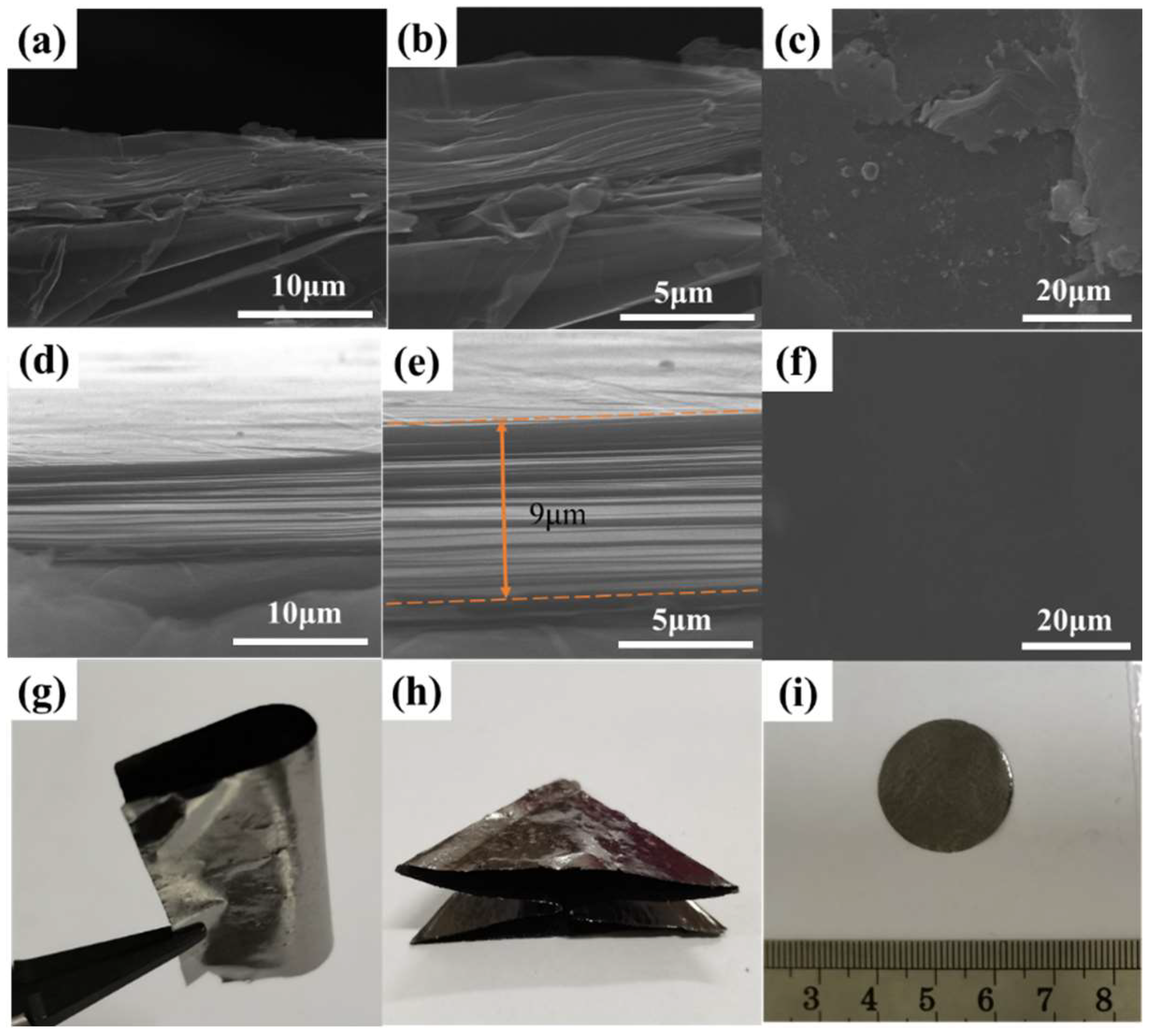
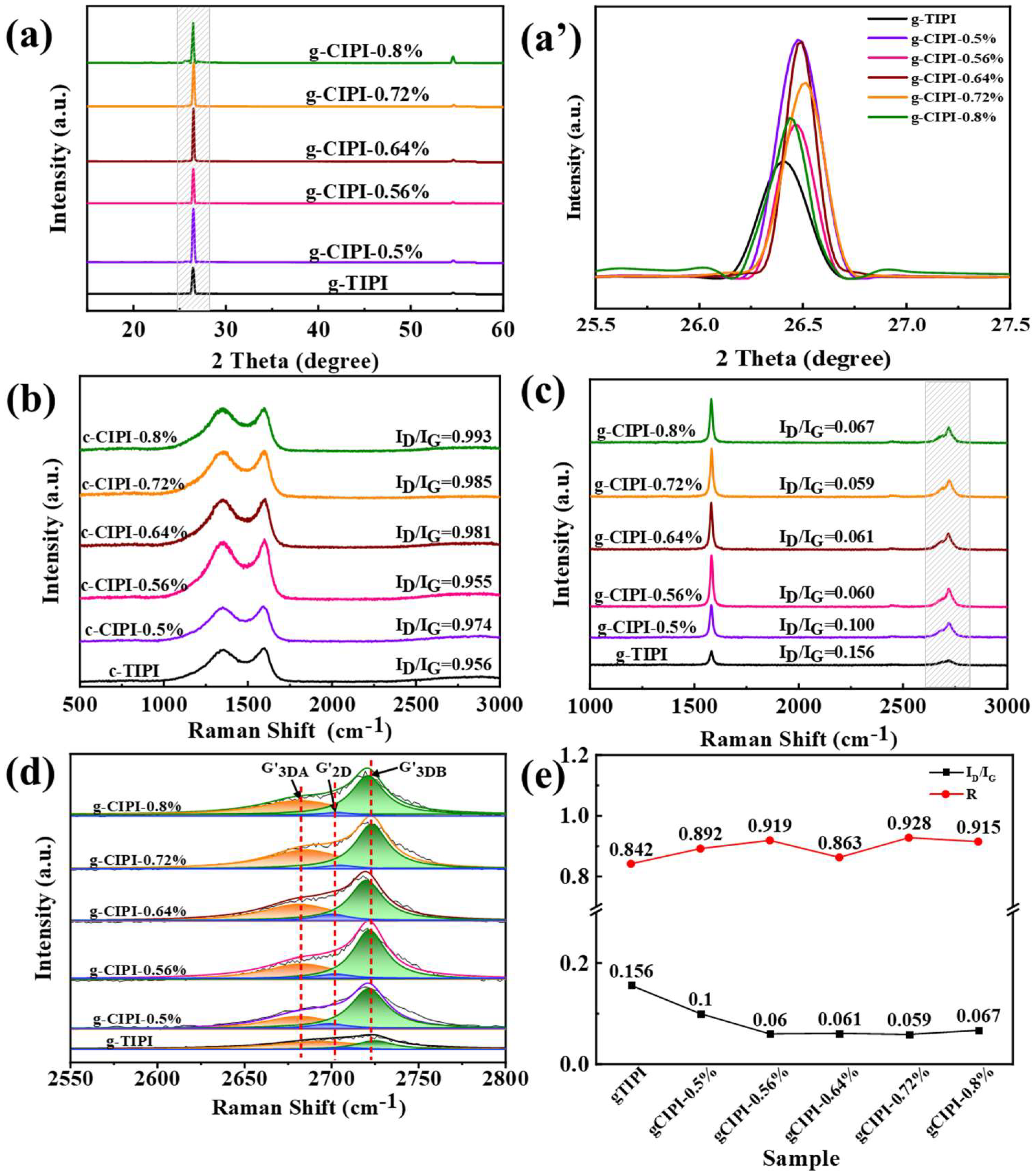
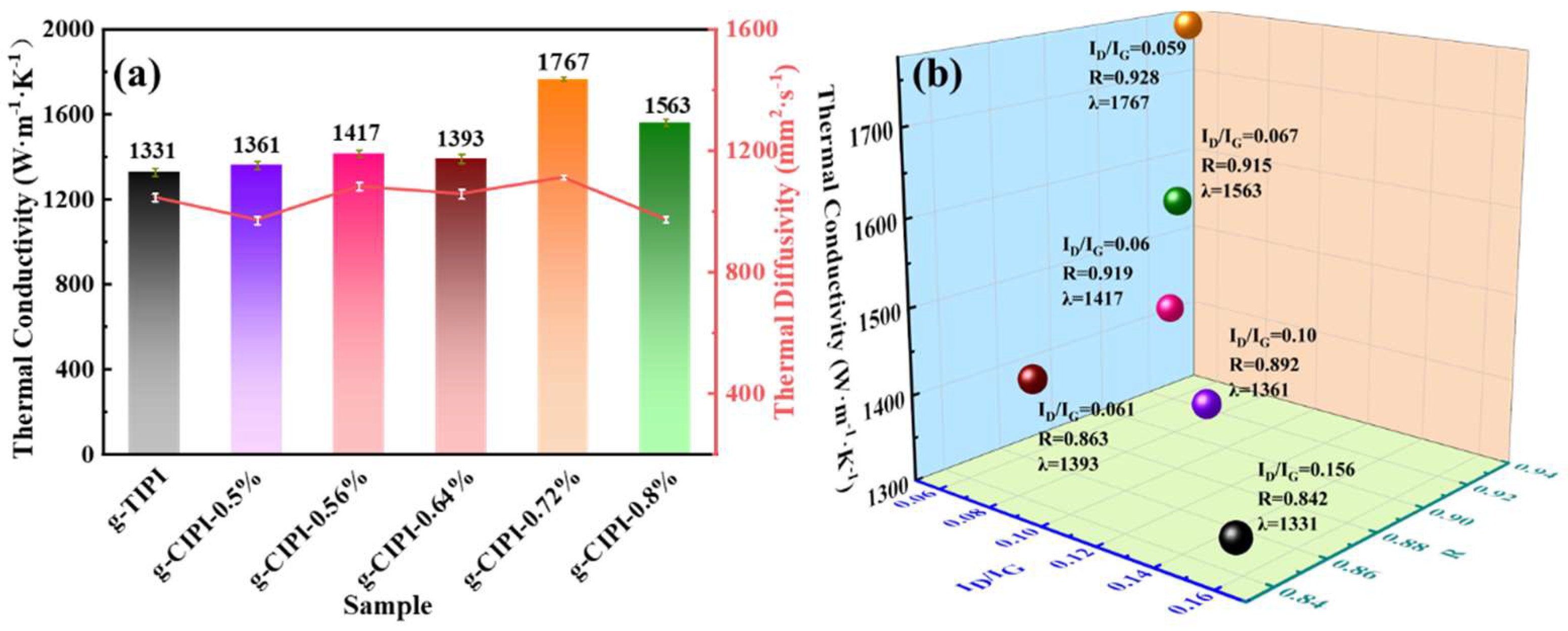
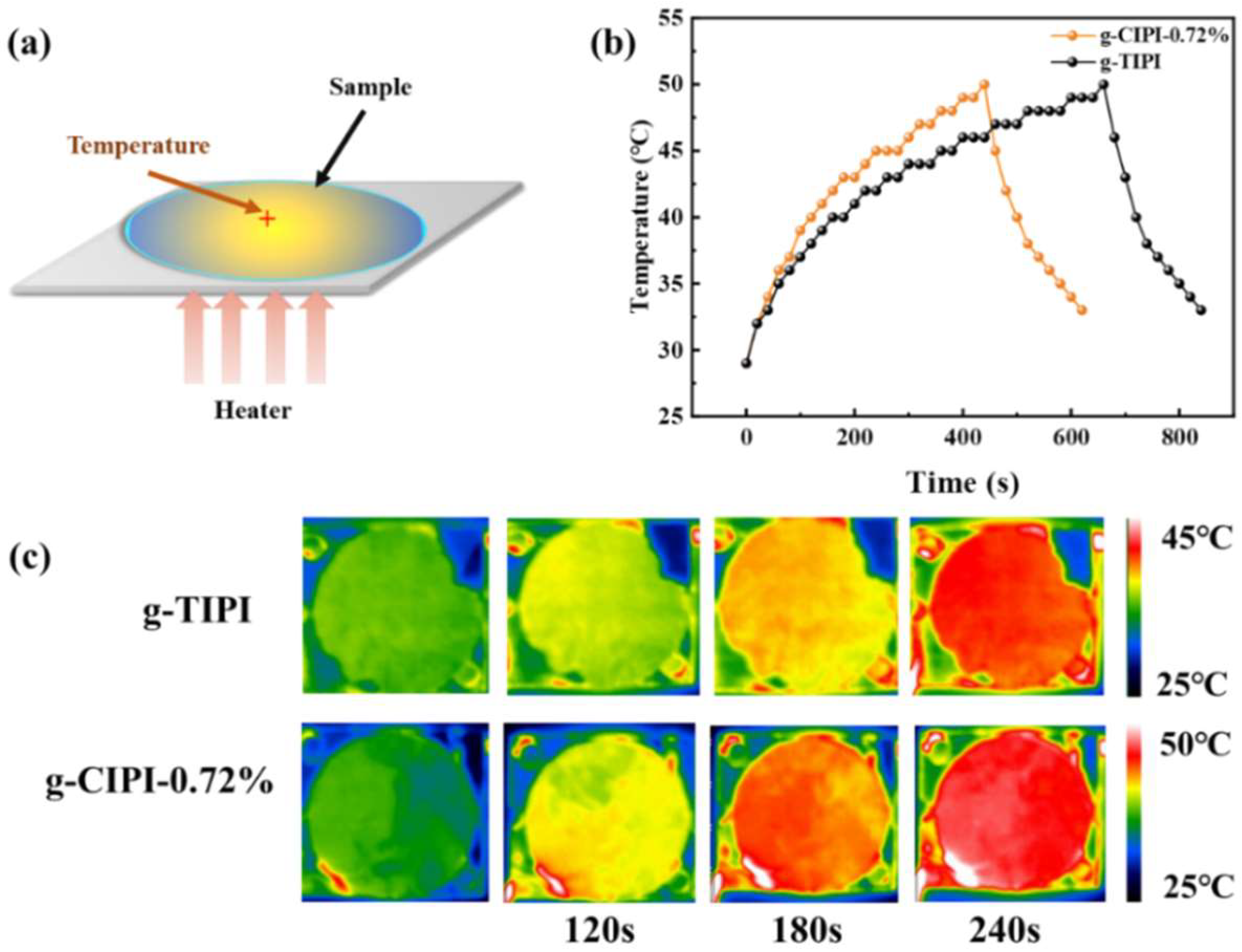
| Sample | ID/% | Tensile Strength/MPa | T5/°C | Tg/°C |
|---|---|---|---|---|
| TIPI | 84.9 | 113.22 | 524.0 | 369.6 |
| CIPI-0.5% | 85.6 | 119.44 | 559.3 | 388.2 |
| CIPI-0.56% | 86.9 | 119.26 | 589.0 | 389.1 |
| CIPI-0.64% | 86.9 | 119.09 | 593.7 | 390.3 |
| CIPI-0.72% | 87.5 | 122.38 | 593.0 | 390.9 |
| CIPI-0.8% | 87.1 | 121.73 | 561.7 | 391.2 |
| 2D Peak Fitting | ID/IG | La (nm) | ||||
|---|---|---|---|---|---|---|
| (a.u.) | (a.u.) | (a.u.) | R | |||
| g-TIPI | 30.65 | 33.89 | 6.36 | 0.842 | 0.156 | 123.21 |
| g-CIPI-0.5% | 51.73 | 154.41 | 18.6 | 0.892 | 0.1 | 192.17 |
| g-CIPI-0.56% | 62.53 | 191.23 | 16.85 | 0.919 | 0.06 | 319.57 |
| g-CIPI-0.64% | 68.12 | 156.88 | 24.94 | 0.863 | 0.061 | 314.82 |
| g-CIPI-0.72% | 72.56 | 172.97 | 13.39 | 0.928 | 0.059 | 324.25 |
| g-CIPI-0.8% | 55.04 | 151.39 | 13.99 | 0.915 | 0.067 | 286.88 |
| Base Material | Filler/Catalyst | Graphitization Temperature/°C | Thermal Conductivity/(W/m·K) | Ref |
|---|---|---|---|---|
| GO | PDA | 3000 | 1584 | [36] |
| PMDA/ODA | - | 3200 | 1950 | [22] |
| PAN | GO | 2800 | 1282 | [21] |
| GF | - | 2850 | 1204 | [6] |
| GE | 2850 | 1529 | [51] | |
| PMDA/ODA | Propionic anhydride/Pyridine | 2950 | 1092 | [29] |
| GO | - | 2750 | 1200 | [52] |
| PMDA/ODA | Phosphorus compound | 2800 | 1767 | This work |
Publisher’s Note: MDPI stays neutral with regard to jurisdictional claims in published maps and institutional affiliations. |
© 2022 by the authors. Licensee MDPI, Basel, Switzerland. This article is an open access article distributed under the terms and conditions of the Creative Commons Attribution (CC BY) license (https://creativecommons.org/licenses/by/4.0/).
Share and Cite
Sun, M.; Wang, X.; Ye, Z.; Chen, X.; Xue, Y.; Yang, G. Highly Thermal Conductive Graphite Films Derived from the Graphitization of Chemically Imidized Polyimide Films. Nanomaterials 2022, 12, 367. https://doi.org/10.3390/nano12030367
Sun M, Wang X, Ye Z, Chen X, Xue Y, Yang G. Highly Thermal Conductive Graphite Films Derived from the Graphitization of Chemically Imidized Polyimide Films. Nanomaterials. 2022; 12(3):367. https://doi.org/10.3390/nano12030367
Chicago/Turabian StyleSun, Meijiao, Xiaoqiang Wang, Zhengyu Ye, Xiaodong Chen, Yuhua Xue, and Guangzhi Yang. 2022. "Highly Thermal Conductive Graphite Films Derived from the Graphitization of Chemically Imidized Polyimide Films" Nanomaterials 12, no. 3: 367. https://doi.org/10.3390/nano12030367
APA StyleSun, M., Wang, X., Ye, Z., Chen, X., Xue, Y., & Yang, G. (2022). Highly Thermal Conductive Graphite Films Derived from the Graphitization of Chemically Imidized Polyimide Films. Nanomaterials, 12(3), 367. https://doi.org/10.3390/nano12030367






